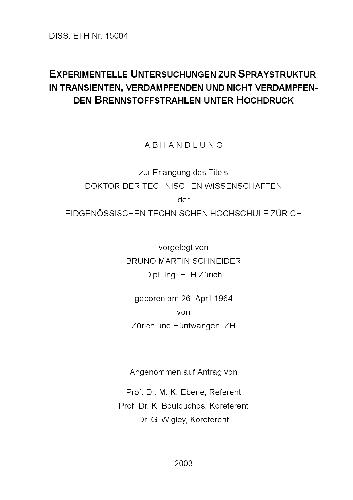Schneider B.M.
The present work is an experimental investigation of high pressure Diesel fuel sprays injected into inert environments under evaporating and non evaporating conditions at high gas pressures.The results further significantly increase current knowledge and understanding of the fundamental processes governing the breakup and atomization of these tran┐sient, high pressure fuel sprays and represent a detailed and solid database for the development and testing of spray models in computational fluid dynamics codes. A high temperature and high pressure constant volume cell was used as experi┐mental device. This combustion cell provides a flexible facility to study sprays over a wide range of environments, including conditions found in Diesel engine combustion chambers. It is equipped with an easy configurable Common Rail Diesel injection system.Two complementary measurement techniques where used: The shadow imaging method in combination with appropriate image processing allows the measure┐ment of the axial and radial penetration as a function of time. It also permits the visualization of structures in the liquid phase of the instantaneous spray. The Phase Doppler Anemometry technique (PDA) measures simultaneously the ve┐locity and size of individual droplets at single locations in the fuel spray. Scanning the measurement point over a grid of locations in the spray allows the character┐ization of the droplet flow field structure in the fuel spray. The following parameter where varied in the experiments of this study: Gas pres┐sure and gas temperature, fuel injection pressure, diameter and length to diameter ratio of the injection nozzle holes (the injector nozzles had always one central hole). This allowed for experiments with up to 96 parameter variations. The measurements of the axial fuel spray penetration over the wide range of gas conditions in this study show the limitations of the corresponding models found in the literature. Most importantly, the influence of the gas density on the initial linear expansion and the influence of the gas temperature on the later propagation of the fuel spray need to be taken into account.Experimental correlations for the fuel spray propagation that have been developed under non evaporating conditions have only a limited usefulness for the estimation of the fuel spray penetration under real diesel engine conditions. The Phase Doppler Anemometry measurements give for non evaporating conditions an average droplet diameter of 8μm (), whereas under evaporat┐ing conditions the droplet diameters are reduced by half to sizes of 4μm and less ().The experimental data in this study could not be interpreted correctly without tak┐ing into account the limitations of the applied measurement techniques. The use of two complementary measurement techniques in the same experiment allows for an easier interpretation of the phenomena found in the measurement data. It is shown as well that the manufacturing quality, i.e. the small differences in the micro geometry of the nozzles, may have an even bigger influence on the fuel spray characteristics than the variation of the nozzle hole dimensions itself. | |

Reviews
There are no reviews yet.